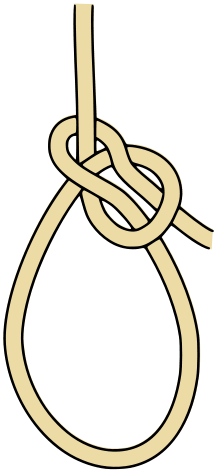Cowboy bowline
The cowboy bowline (also left-hand bowline, Dutch marine bowline or winter bowline) is a variation of the bowline loop knot.
| Cowboy bowline | |
|---|---|
 | |
| Names | Cowboy bowline, left-hand bowline, Dutch bowline, Dutch marine bowline, winter bowline |
| Category | Loop |
| Related | Bowline, Eskimo bowline, sheet bend |
| Releasing | Non-jamming |
| ABoK | #1034½ |
The cowboy bowline has the working end go around the standing part on the side closer to the loop and results with the working end outside the loop. In contrast, a regular bowline has the working end finishing inside the loop. (The "rabbit" goes around the "tree" in the opposite direction from normal.) The Ashley Book of Knots states that it is "distinctly inferior" to the standard bowline[1] because of its similarity to the left-hand sheet bend.[2] Various tests of the different versions' strengths show little difference; conjecture about either knot's vulnerability to some failure remain pretty much only that – conjectures.
As for the tail of a regular bowline finishing "inside the loop [ eye]", that is more a formal-image state than one of an actual knot, as the draw of the standing part will pull the tail around so that it actually points away from the eye, but there are various ways the knot can be dressed to affect this aspect.
Some hearsay suggest the Dutch Navy uses (or used) this variant of the bowline because they consider it superior since the working end is not so easily pushed back by accident. However, there is no documentation to confirm this claim, and some Dutch knot tyers outright deny it.
Another piece of unverified lore is that it is called a winter bowline because the exposed working end on the outside would blow in the wind and prevent it from freezing to the loop on ships in the north Atlantic during winter. (This suggests that the standard bowline would be the summer bowline.)

(a) – free end of the rope, (b) – load.
Security
There is a rule of thumb which states that the loose end should be as long as 12 times the circumference of the cord for the sake of safety.[3]
See also
References
- Clifford W. Ashley, The Ashley Book of Knots (New York: Doubleday, 1944), 188.
- Clifford W. Ashley, The Ashley Book of Knots (New York: Doubleday, 1944), 16.
- "Roper's Knot Pages - Single loops". www.realknots.com. Retrieved 2018-07-10.